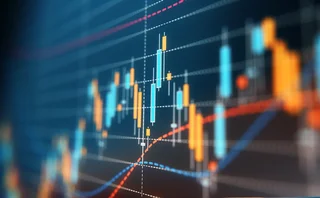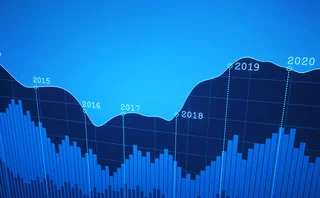
Goldman Sachs Asset Management
Opposites attract, as the saying goes, and the three-strong emerging market debt team at Goldman Sachs Asset Management certainly combines a diverse set of skills and experience—to dramatic effect. Dalia Fahmy profiles the team

A quaint reminder of how much emerging markets have changed lies yellowed under a stack of dusty newspapers at Goldman Sachs Asset Management: the unlikely sight of a Peruvian horn. “Every time a country missed a payment we would blow the default horn,” says 30-year-old emerging market portfolio manager Sam Finkelstein, inspecting the colorful Peruvian souvenir which his colleague Ricardo Penfold brought back from a business trip. “It used to sit right there on my computer, but now it’s shoved all the way in the back because in the past couple of years it hasn’t been needed.”
Finkelstein, an intensely focused former currency trader, is the risk expert on the three-member emerging market debt team at Goldman Sachs Asset Management. Penfold, a tan Venezuelan economist with unruly hair, leads sovereign research, and their boss Owi Ruivivar from the Philippines, a self-labeled ‘geek’ whose office whiteboard is covered in mathematical formulas, oversees the portfolio.
Together, they manage $2 billion for GSAM, and have beaten the sector benchmark every year since joining forces three years ago. Their Goldman Sachs Emerging Market Debt fund rose 13.56% through November 24, making it the second-best performer in emerging markets and one of the top 10 across all fixed-income categories, according to Morningstar. In the same period, the JPMorgan Emerging Market Bond Index (Embi) Global rose 7%.
The three portfolio managers reach for canned responses when asked about their success, bandying about terms like “global reach” and “relative-value discipline.” But eventually it becomes clear that their strength lies in various skills and perspectives each of them brings to the investing process.
Ruivivar, a 34-year-old soft-spoken Harvard University economics graduate who began her career at the International Monetary Fund, likes to build computer models that distill reams of government balance sheets into graphs and tables. “We have a pretty formalized quantitative approach to modeling cross-country fundamentals,” she says from her narrow twenty-fourth floor office overlooking the East River in New York, noting that the team’s ability to compare macro indicators efficiently and generate its own credit ratings has been crucial.
Penfold uses his native Spanish and experience culled as an economist at Santander Investments and Banco Santander Central Hispano to collect facts, rumors and predictions from local sources, such as government officials, bankers and journalists. The 41-year-old father of five travels frequently to Latin America to perform what he calls the trickiest part of the job: discovering changes in a country’s creditworthiness before the market does.
Finkelstein specializes in technical bond analysis and risk management, cultivating close ties with salespeople and dealers at other banks, and trading throughout the day to keep the portfolio balanced.
It’s easily apparent that Ruivivar, Penfold and Finkelstein possess an enviable rapport and that their often contradictory opinions, which they don’t shy from wrangling out in front of strangers, spark valuable debates.
In addition to this chemistry, the three have been blessed with the longest rally in emerging market history, with the Embi Global up an average 15% each of the past three years and spreads against US Treasuries narrowing to their tightest levels since 1997. But rallies can’t last forever, and this one is winding down. Last year’s 7% return on the Embi Global was down sharply from the whopping 22.73% gain of 2003. A series of market dips in 2004 scared off many bulls, and most experts agree that emerging market bonds are due for a correction this year and maybe next.
Gradual recovery
When Ruivivar graduated as a doctoral fellow from the Massachusetts Institute of Technology in 1997 and joined BNP Paribas in New York as an emerging market economist, the world’s developing economies were teetering on the brink of collapse. The once roaring ‘economic tigers’ of Southeast Asia—particularly Thailand, South Korea, Malaysia, Hong Kong and Indonesia—were fending off violent speculations against their currencies. Investors had suddenly started paying attention to the unrealistic debt-to-GDP ratios, current account deficits and overvalued currencies which had artificially pumped up emerging market asset valuations. By the end of 1999, countries from Thailand to Russia to Brazil had devalued their currencies, and bond defaults ran rampant.
At the time, few would have predicted the recovery that has unfolded since. Last year, Thailand, Brazil and Russia all posted current account surpluses and GDP growth averaged 6%, 5% and 7% respectively. It’s true that occasional crises, such as Argentina’s massive default three years ago, have kept emerging markets in the headlines, but overall the landscape is a far cry from what it used to be.
More than 40% of issuers in the Embi Global are now rated investment grade by the credit rating agencies, compared with just 4% during the slump of 1998. Wall Street analysts predict that 10 more countries will be bumped up to investment grade in 2005, including former trouble spots Russia and Indonesia. The Embi Global spread, which hit a record high of 1,631 in 1998, now hovers under 400.
But skeptics who remember the exuberance that prefaced previous crises say much of the current optimism is misplaced. “One might ask how much structural improvement has there been in emerging market economies? We would argue not that much,” says Rashique Rahman, chief emerging market debt strategist at HSBC Securities, noting that many emerging market economies benefited from strong global growth and high commodity prices last year. “There has been some credit improvement for sure, but a lot of that has been cyclically derived.”
The GSAM team agrees that emerging markets have gained from what Ruivivar describes as a “sweet spot” in the cycle, but feels that bears are not giving enough credit where it’s due. “[Critics] are just saying that these countries were lucky, and haven’t done their work,” says Penfold. “That’s just not true. There are a lot of problems that still have to be solved in these countries, but I think they are also reaping the benefits of major reforms.”
Since the crises of the 1990s, many emerging market economies have floated their exchange rates, boosted the capitalization of their banks, reduced their dependence on imports and tightened their fiscal belts, says Penfold. As a result, currencies are now generally fairly valued, current account balances have improved dramatically and international currency reserves are higher. At the same time, many countries have been slowly weaning themselves off hard currency borrowing and cutting their overall debt levels. These measures have reduced vulnerability to external shocks, says Ruivivar, but they also signal a fundamental transformation. “There’s a very interesting psychological shift,” she says. “We really don’t think it was accidental.”
Arturo Porzecanski, the head of emerging markets sovereign research at ABN Amro who has covered the developing economies for 28 years, says the truth lies somewhere in between. “It’s a mix. Clearly the winds are favorable now,” he says, pointing to high commodity prices, low interest rates and a political calendar free of dreaded “cliffhangers”. However, “progress has been made, and some of the gains are fairly permanent. I don’t have to stay awake at night anymore worrying whether this is the night when a country will decide to devalue its currency.”
Investment process
Whether one attributes the recent strength in emerging markets to discipline or luck, there’s no doubt that the GSAM team is doing something right as it has consistently outperformed the market in the past three years. In 2004, the bets that propelled GSAM included stakes in oil-exporting countries such as Russia, Venezuela and Ecuador, and an overweight position in local US dollar-denominated Argentine Boden bonds, which paid coupons even though the sovereign had defaulted on its external debt.
Ruivivar describes their investing method as a four-step process. First, the group discusses its outlook for emerging market fundamentals, valuations and technicals, establishing broad economic themes. During this stage, Ruivivar, Penfold and Finkelstein set their expectations for variables such as economic growth, market liquidity, geopolitical risks and commodity prices.
In 2004, for example, the group decided early on that since global economic conditions seemed to favor higher oil prices, the fund should be overexposed to oil exporters—a bet that paid off handsomely as countries like Russia and Ecuador achieved record revenues.
In the second stage, the team determines creditworthiness country by country. During this process, they generate their own economic research and quantitative models which they say help provide insights into markets like Romania or the Dominican Republic, which are not usually covered by Wall Street researchers. Then, decisions are made on key country allocations and deviations from the benchmark, usually by combining qualitative and quantitative insights to varying degrees. “There are some moments in time when fundamentals are everything that matters, and there are other moments when fundamentals are kind of a dull backdrop that everybody agrees on, but technicals are driving the market,” says Ruivivar.
During the third stage, the team picks individual securities. They take into account the usual parameters of bond picking, but also dig for value in unusual places. Recently, the group has increasingly dipped into local currency securities, which are becoming a new favorite instrument for borrowers who have traditionally focused on US dollar- or euro-denominated debt.
At the very end, the portfolio is fine-tuned for risk. Finkelstein ensures that the selections are in line with investor mandates and risk parameters. Throughout this process, says Ruivivar, the group works closely with GSAM counterparts in London and Tokyo who specialize in regional non-emerging market economies, interest rates and foreign exchange.
While the New York team, with three members, is smaller than many others at competing firms, GSAM chief investment officer and fixed-income co-head Jonathan Beinner says this adds to its strength. “You can make decisions rapidly, you can take advantage of opportunities quickly, you don’t get bogged down in committees,” he says. “You also have much more ownership of decisions.”
Ruivivar, Penfold and Finkelstein concede that in 2005, emerging market debt is headed for a slowdown, but they argue that gains can still be had. Above all, Ruivivar recommends emerging market debt as a way to diversify and benefit from the current upward momentum of credit ratings. Emerging market borrowers have seen more upgrades than downgrades by the rating agencies in the past three years, she points out, bringing an average rating of double-B plus within reach in 2005, from the current average of double-B.
Fundamentals in 2005 will resemble 2004, she says, with economic growth that’s softening but still firm, slight inflation and liquidity that’s shrinking but still healthy. Risks for emerging markets are mainly external, and depend largely on US monetary policy.
The price of raw materials is a wild card that will determine the fate of countries from Latin America to Eastern Europe, many of which rely heavily on commodity exports. Markets are counting on oil to be range-bound between $30 and $45 next year, so the GSAM team remains bullish on oil exporters. A sharp decline, however, could deal a severe blow to countries like Ecuador, Venezuela, Mexico and Russia.
Another wild card is presidential elections scheduled in Colombia, Peru, Venezuela, Brazil and Mexico in 2006. In the past, political uncertainty roiled investors who feared that fiscal profligates would take office, but Penfold says things have changed. “We’re seeing a more prudent and socially responsible emerging market political class that realizes in order to promote growth, you need fiscal and monetary discipline,” he says.
Partly thanks to this newfound discipline, governments have begun developing a local currency bond market which Finkelstein recommends jumping into “early in the game”. He adds, “What you’ve seen is the better tier of emerging market countries regain access to local capital markets.” A decade ago, he explains, emerging market countries were unable to issue long-dated bonds in their local currencies because investors feared inflation and devaluation. Instead, borrowers relied on hard currency issuance, which exposed them to foreign exchange fluctuations. As emerging market borrowers improve their credit profile and many graduate to investment grade, they are likely to increasingly move away from external debt and focus on their local markets.
More broadly speaking, GSAM currently favors Latin America, with 44% of the portfolio allocated there compared with 27% in eastern Europe, 8% in Asia and 6% in Africa and the Middle East. Specifically, the team is overweight in Brazil with 12.4% of the portfolio, in Argentina with 5%, in Ecuador with 4% and in Russia with 12%.
Brazil has been an investor favorite following a lackluster start to the year, due to its relatively high economic growth, fiscal discipline and efforts to reduce its dollar-denominated debt. Penfold says the Brazilian central bank has been able to establish itself as an independent organization that is serious about meeting inflation targets and adds that its recent bout of monetary tightening was well played. The Brazilian central bank has raised its benchmark Selic lending rate three times in as many months to 17.25% in its fight against inflation.
The biggest challenge for the world’s ninth-largest economy, says Penfold, is bringing down 7% inflation and completing microeconomic reforms. A labor reform to reduce unit labor costs currently under consideration would help boost investment and should help Brazil achieve sustainable economic growth.
“They have the groundwork: they’ve been able to stabilize the economy, inflation is coming down, the fiscal accounts are looking better,” says Penfold. “Now you need to move in another direction and try to push forward the private investment and bring down interest rates so the government has more room to spend in the social area.”
Ruivivar says Brazil must pass the baton from consumer- and export-driven economic growth to a more sustainable form of expansion underpinned by private investment. Investors will also be looking for Brazil to improve the composition of its debt, which consists heavily of floating-rate issues and which Penfold says has always been an “Achilles heel” that robbed the government of much-needed leeway in monetary and foreign exchange policies.
Not far from Brazil geographically, but light years away economically, is another GSAM overweight: Argentina. The group expects Argentina to recover from its recent doldrums, particularly once the bond restructuring is completed. Argentina defaulted on $88 billion in bonds in December 2001, the largest sovereign default in history. The government has tried to squeeze as many concessions from investors as possible, offering them a fraction of their investment and sometimes even refusing to negotiate. But recently talks have rolled into full gear and Finkelstein says he expects a resolution soon. GSAM’s 4.8% allocation to Argentina consists largely of the defaulted bonds.
“Argentines have always been tremendous liability managers, their human capital has always been impressive,” says Finkelstein, adding that Argentina’s government has thrown its weight behind the creditor reconciliation process because it knows that it will eventually need fresh access to capital markets in order to sustain economic growth.
Market consensus is far from unanimous that Argentina will manage to renegotiate its debt, and there has been frequent speculation as to whether the government will be able to get enough creditors on its side. ABN Amro’s Porzecanski says failure to restructure would actually boost emerging market sentiment, as it would prove that large debtor countries can no longer slide out the back door of default.
Another GSAM favorite is Peru, which Penfold says pulled off its transition from the long-standing government of Alberto Fujimori to the current administration under President Alejandro Toledo three years ago without too much trauma. He says Peru has shown itself to be fiscally prudent, has opened up the mining sector to private investors, and managed to smartly capitalize its pension liabilities with privatization revenues. “If Peru is able to de-dollarize more, and can go over the hurdle of upcoming elections... then I think Peru is the next investment-grade country in the region,” says Penfold.
The team also likes Russia because of strong macroeconomic fundamentals and cashflows which give it a “tremendous ability to pay off debt”, says Finkelstein.
On the negative side, the fund is underweight on the Philippines and Colombia. Ruivivar, who comes from the Philippines and also covers the credit, is critical about the current administration’s fiscal policies. “The Philippines has a potential solvency problem,” she says, echoing concerns that have whipped the country’s bonds in the past year and compelled Moody’s to threaten it with a downgrade. The Philippines’ public debt-to-GDP ratio is one of the highest in emerging markets, at over 120%, and its 2004 borrowing needs are impossible to fulfill, according to some critics.
“The fiscal situation is not improving,” she adds, “and not strong enough to bring that solvency into a positive trajectory. We feel that unless the Philippines initiates important fiscal reforms, this new administration could have some solvency difficulties in the future.”
As for Colombia, Penfold says the market has priced in too many of the positives, such as the expected reelection of President Alvaro Uribe, and not enough of the negatives, such as the possibility that the Colombian legislative will not pass all the necessary items in the pension and tax reforms. At the same time, Colombia is relying heavily on privatization revenues this year, a bet which could easily sour if emerging markets head south, forcing Colombia to issue new debt instead.
Emerging danger
As for the most important question on everybody’s mind? The team says a global meltdown similar to those of the past is highly unlikely today, but the risk of getting burned remains. Argentina’s default and the ongoing, fitful restructuring talks prove that developing economies are far from attaining the credibility of their G7 counterparts. Currently, the Ivory Coast and Serbia are in default, in addition to Argentina and Iraq, and several more rely on IMF funding.
But the danger of contagion has receded, says Ruivivar. “If you look at episodes of emerging market crises from 1999 onwards, where you had a number of country-specific crises, you will see that bouts of volatility have been a lot more subdued than during the Asia Crisis or the Peso Crisis of 1994–1995,” she says. This reduced volatility means that emerging market debt “smells and looks less like an equity class, and more like a fixed-income asset class”.
Another recent development which should minimize contagion is that investors understand emerging markets better and are able to differentiate between credits, says Penfold. “Before, they used to throw everything in one pile,” he says.
The improved availability of data from borrowers—on the internet, but also through traditional channels which local officials had previously neglected—also helps reduce uncertainty and confusion that often exacerbated speculative runs. At the same time, emerging market investors are more diverse now than five years ago. Beinner says GSAM’s clients include a wide range of hedge funds, mutual funds and the more conservative core-plus investors.
“Because you have a more diversified investor base with different objectives and different constraints, their choices are more heterogeneous,” explains Ruivivar. “So you’re not going to have the kind of herding effect you had before.”
Only users who have a paid subscription or are part of a corporate subscription are able to print or copy content.
To access these options, along with all other subscription benefits, please contact info@risk.net or view our subscription options here: http://subscriptions.risk.net/subscribe
You are currently unable to print this content. Please contact info@risk.net to find out more.
You are currently unable to copy this content. Please contact info@risk.net to find out more.
Copyright Infopro Digital Limited. All rights reserved.
You may share this content using our article tools. Printing this content is for the sole use of the Authorised User (named subscriber), as outlined in our terms and conditions - https://www.infopro-insight.com/terms-conditions/insight-subscriptions/
If you would like to purchase additional rights please email info@risk.net
Copyright Infopro Digital Limited. All rights reserved.
You may share this content using our article tools. Copying this content is for the sole use of the Authorised User (named subscriber), as outlined in our terms and conditions - https://www.infopro-insight.com/terms-conditions/insight-subscriptions/
If you would like to purchase additional rights please email info@risk.net
More on Economics
Webinar – Nowcasting the US economy
Join CME Group Chief Economist, Blu Putnam, as he shares insights using alternative data and nowcasting to monitor developments in the US economy.
Fed Funds Futures in a Post-ZIRP World
As the FOMC returns to more active management of its key target rate, Federal Funds futures have experienced dramatic growth.
Challenging economic pessimism: an optimistic note
A contrarian, upbeat view of the long-term economic outlook
Economists, like hedge fund traders, need open minds
Economists, risk managers and traders must learn the lessons of crisis, says Kaminski
Fed wrong not to start QE tapering, says UBS economist
The surprise decision by the Federal Reserve last month not to scale back its quantitative easing programme will create more volatility, says economist
IMF's Blanchard warns Europe could drag world economy down
IMF chief economist says ‘three-speed’ global economy could be dangerous







